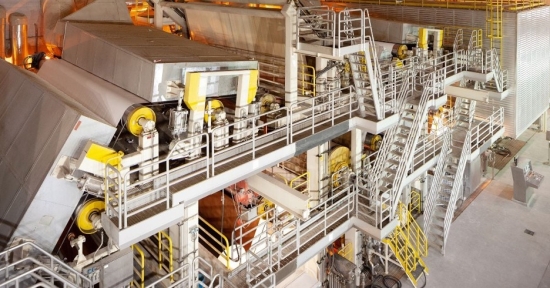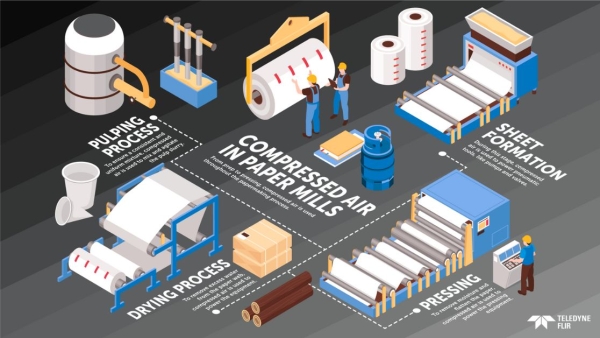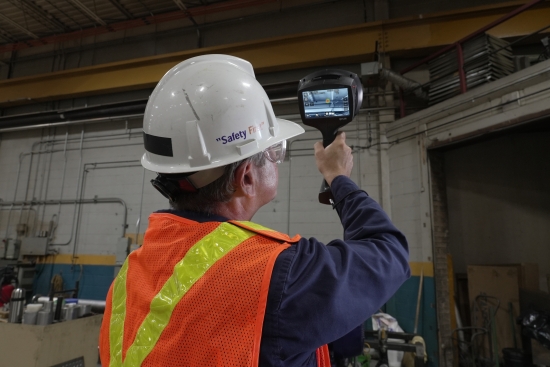Detecting Compressed Air Leaks Can Lead to Reduced Energy Waste, Boosted Productivity, and Improved Profits for Paper Mills

Pulp and paper mill sheet formation and pressing machinery.
Many manufacturing industries including food and beverage, chemical, mining and pulp and paper are heavily reliant on the use of compressed air within their production processes. Paper mills are major industrial facilities that rely on compressed air throughout the entire process as it is used to separate and clean the raw pulp fiber, operate pneumatic tools, and even control valves.
The global consumption of paper and paperboard reached 408 million tons as recently as 2021. And today, mills are shifting from traditional paper to more sophisticated products like high-end packaging solutions and specialty papers. To keep up with growing demand, pulp and paper mills need a constant supply of compressed air to maintain production.
Compressed air leaks may seem to some like a minimal problem that can be either delayed or ignored, yet over time they will result in significant energy waste, reduced productivity, and increased operating costs. One of the most effective ways to detect compressed air leaks in pulp and paper mills is through the use of acoustic imaging cameras. Energy expenses, particularly in compressed air systems, account for a significant portion of total production costs in the pulp, paper, and board industry, making it crucial to address these challenges promptly.

Figure 1. Various stages of the paper production process.
Acoustic Cameras Answer the Call
Acoustic imaging cameras have become a valuable and efficient resource for detecting compressed air leaks in pulp and paper production. These cameras offer the advantage of swiftly and precisely pinpointing the origin of air leaks, requiring minimal training from operators, even in the noisiest work environments. As a result, pulp and paper producers can promptly take corrective measures to decrease energy waste while optimizing the performance of their equipment to improve productivity and quality.
How Acoustic Cameras Are Applied to Compressed Air Leaks
Compressed air is used in various stages of the paper production process, resulting in a pulp that is mixed with water and chemicals to create a slurry, and into paper products. Compressed air is used to mix and agitate the slurry to ensure a consistent and uniform mixture. Pulp slurry is then fed into a paper machine to form paper web. During this sheet creation stage, compressed air powers various pieces of pneumatic equipment used to regulate the flow of liquids and gases. Once the paper is formed, it undergoes a pressing process to remove excess water and flatten the sheet. Compressed air is used to power the pressing process to remove excess water and to facilitate the drying process.
Finally, coatings and final treatments are added to the paper to enhance its performance or appearance. This can include adding finishes like gloss or matte, coatings that make the paper water-resistant, or treatments that improve the print quality of the paper. Compressed air is often used in the coating application process.

A worker conducts an inspection looking for air leaks with the FLIR Si124-LD acoustic imaging camera.
Challenges of Detecting Compressed Air Leaks
Pulp and paper mills are typically complex facilities that often operate 24/7, with various stages of the paper production process running simultaneously. This creates a challenging environment for commonly used leak detection techniques, as there are numerous areas where leaks can occur. Some traditional leak detection methods, such as sniffers and leak spray, can also be limited in their effectiveness in detecting compressed air leaks in pulp and paper mills.
Sniffer tools use a detector wand to detect leaks from a unit filled with a tracer gas. The tool is moved over the part and detects the leak as it passes over it. The sensitivity of the probe, the speed of movement, and the distance from the part all determine the accuracy of leak detection. Sniffing techniques can locate leaks on a part and can detect even minute leaks. However, they are operator-dependent and can also miss leaks, making them unsuitable for high volume production environments. Leak spray involves applying a soapy solution to the suspected area of the leak and looking for bubbles but, again, this method can result in missing small leaks or leaks in hard-to-reach areas.
Proven Advantages of Acoustic Inspections
The most popular traditional method for identifying air compressor leaks is a single-transducer ultrasonic acoustic detector. This electronic device can detect high-frequency sounds that indicate air leaks. However, the traditional method of using a single-transducer ultrasonic system is like using a spot temperature sensor for thermography inspections - it is functional, but can be time-consuming, and maintenance crews must often use them during scheduled downtime. Furthermore, to be effective, operators require extensive training and months of practice.
Acoustic cameras can detect and pinpoint the distinctive noise of a compressed air leak from a long distance, making it ideal for the noisy environment of large paper-making facilities. An advanced acoustic imaging camera can distinguish between sounds like an air leak despite background noise by identifying the specific acoustic signature of a leak through artificial intelligence (AI).. The camera visually shows the location of the leak, saving the inspector a a significant amount of time without potentially requiring months or years of training.

Fig. 2. Where to Look for Compressed Air Leaks in Paper Mills
Cost Savings
Detecting and repairing compressed air leaks using acoustic imaging cameras can also result in significant cost savings. By reducing energy consumption and improving the performance of equipment, mills can lower their operating costs and increase their profitability. To better visualize the total cost savings an acoustic imaging camera, a return-on-investment (ROI) calculator can be used. This comes in the form of an online tool that allows you to estimate the potential energy savings from detecting and repairing air leaks, in relation to the cost of the camera itself. Acoustic cameras can also provide on-camera and in-software leak quantification and cost analysis to help prioritize which leaks to fix first to achieve maximum savings.
Conclusion
The paper-making industry has made strides in recent years to become more environmentally sustainable, with many mills implementing eco-friendly practices such as using recycled materials, reducing waste, and utilizing renewable energy sources. Acoustic imaging utilizing AI, leak cost analysis and fleet management tools are fast becoming a key method for the industry to reduce energy usage while improving productivity and asset reliability.
About Teledyne FLIR
Teledyne FLIR, a Teledyne Technologies company, is a world leader in intelligent sensing solutions for defense and industrial applications with approximately 4,000 employees worldwide. Founded in 1978, the company creates advanced technologies to help professionals make better, faster decisions that save lives and livelihoods. For more information, please visit www.teledyneflir.com.
Author Biography
Rob Milner, global business development and engineering, has worked in business development and sales roles for FLIR, a Teledyne Company, for twenty years, where he has experience across multiple industrial vertical businesses. Milner holds a MSc (Metallurgical Engineering) and a BSc (Metallurgical Engineering). His work has been published in NACE on the topic of Carburization of Advanced Alloys in 1997.

Rob Milner.
To read articles on Compressed Air Leak System Assessments, visit www.airbestpractices.com/system-assessments/leaks.
For expert presentations, visit our Webinar Archive Section dedicated to Compressed Air Measurement at www.airbestpractices.com/webinars.
Published in the March 2024 Issue of Compressed Air Best Practices® Magazine.




